Weronika Golletz with the best poster
Weronika Golletz won the poster competition during 777. WE-Heraeus-Seminar on "Ultracold Quantum Matter: Basic Research and Applications", 12 – 16.12.2022, at the Physikzentrum Bad Honnef (Germany).
"N impenetrable particles bouncing on a mirror: discrete time crystals"
Jacek Dziarmaga, Marek Rams, Wojciech Żurek: publication in Physical Review Letters

It is now widely accepted that quenches through the critical region of quantum phase transitions result in post-transition states populated with topological defects—analogs of the classical topological defects. However, consequences of the very nonclassical fact that the state after a quench is a superposition of distinct, broken-symmetry vacua with different numbers and locations of defects have remained largely unexplored. We identify coherent quantum oscillations induced by such superpositions in observables complementary to the one involved in symmetry breaking. These oscillations satisfy Kibble-Zurek dynamical scaling laws with the quench rate, with an instantaneous oscillation frequency set primarily by the gap of the system. In addition to the obvious fundamental significance of a superposition of different broken symmetry states, quantum coherent oscillations can be used to verify unitarity and test for imperfections of the experimental implementations of quantum simulators.
Phys. Rev. Lett. 129, 260407 (2022)
Ranking TOP %2
12 scientists from the Institute of Theoretical Physics are on the TOP 2% list - a ranking prepared by Stanford University in cooperation with Elsevier and SciTech Strategies:
- Prof. Andrzej Białas
- Prof. Piotr Bizoń
- Dr. Bogdan Damski
- Prof. Jacek Dziarmaga
- Prof. Wojciech Florkowski
- Prof. Romuald Janik
- Prof. Andrzej M. Oleś
- Prof. Adam Rycerz
- Prof. Krzysztof Sacha
- Prof. Józef Spałek
- Prof. Jakub Zakrzewski
- Prof. Karol Życzkowski
Samapan Bhadury, Wojciech Florkowski, Amaresh Jaiswal, Avdhesh Kumar, and Radoslaw Ryblewski; publication in Physical Review Letters
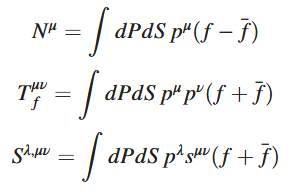
Starting from the kinetic theory description of massive spin-1/2 particles in the presence of a magnetic field, equations for relativistic dissipative nonresistive magnetohydrodynamics are obtained in the small polarization limit. We use a relaxation-time approximation for the collision kernel in the relativistic Boltzmann equation and calculate nonequilibrium corrections to the phase-space distribution function of spin-polarizable particles. We demonstrate that our framework naturally leads to emergence of the well-known Einstein–de Haas and Barnett effects. We obtain multiple transport coefficients and show, for the first time, that the coupling between spin and magnetic field appear at gradient order in the hydrodynamic equation.
Phys. Rev. Lett. 129, 192301 (2022)
Maciej Hendzel, Maciej Fidrysiak, Józef Spałek; publication in Journal of Physical Chemistry Letters
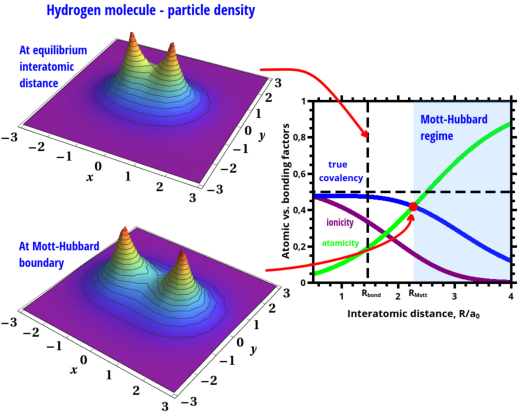
A precise discussion of a single bond requires consideration of two-particle wave function for the particles involved. Here we define and determine rigorously the intrinsically covalency and connected characteristics on the canonical example of H2 molecule. This is achieved by starting from analytic form for the two-particle wave function for electrons forming the bond, in which we single out the atomic contribution (atomicity) in an unequivocal manner. The presence of the atomicity and ionicity factors complements the existing attributes of the bond. In this way, a gradual evolution of the molecular state to its two-atom correspondant is traced systematically with increasing interatomic distance. In effect, a direct relation to the onset of incipient Mott-Hubbard atomicity (Mottness) to the intrinsic covalency and ionicity is established. This goal is achieved formally by combining the single-particle wave function readjustment in the entangled state with a simultaneous determination of two-particle states in the particle (second-quantization) representation.
J. Phys. Chem. Lett. 13, 10261–10266 (2022)
Józef Spałek, Maciej Fidrysiak, Michał Zegrodnik, Andrzej Biborski; publication in Physics Reports

The principal purpose of this topical review is to single out some of the universal features of high-temperature (high-$T_c$) and related strongly-correlated systems, which can be compared with experiment in a quantitative manner. The description starts with the concept of exchange-interaction-mediated (real-space) pairing, combined with strong correlations among narrow band electrons, for which the reference state is that of the Mott-Hubbard insulator. The physical discussion of concrete properties relies on variational approach, starting from generalized renormalized mean-field theory (RMFT) in the form of statistically-consistent Gutzwiller approximation (SGA), and its subsequent generalization, i.e., a systematic Diagrammatic Expansion of the Variational (Gutzwiller-type) Wave Function (DE-GWF). In particular, a detailed phase diagram is obtained (cf., e.g., the figure). In the second part, we generalize our approach to the collective spin and charge fluctuations in high-$T_c$ systems, starting from variational approach, defining the saddle-point state, and combining it with $1/N$ expansion. The present scheme differs essentially from that starting from the saddle-point Hartree-Fock approximation, and incorporating the fluctuations in the random phase approximation (RPA). The spectrum of collective spin and charge excitations is determined.
Markus Schmitt, Marek Rams, Jacek Dziarmaga, Markus Heyl, Wojciech Żurek; publication in Science Advances

The quantum Kibble-Zurek mechanism (QKZM) predicts universal dynamical behavior near the quantum phase transitions (QPTs). It is now well understood for the one-dimensional quantum matter. Higher-dimensional systems, however, remain a challenge, complicated by the fundamentally different character of the associated QPTs and their underlying conformal field theories. In this work, we take the first steps toward theoretical exploration of the QKZM in two dimensions for interacting quantum matter. We study the dynamical crossing of the QPT in the paradigmatic Ising model by a joint effort of modern state-of-the-art numerical methods, including artificial neural networks and tensor networks. As a central result, we quantify universal QKZM behavior close to the QPT. We also note that, upon traversing further into the ferromagnetic regime, deviations from the QKZM prediction appear. We explain the observed behavior by proposing an extended QKZM taking into account spectral information as well as phase ordering. Our work provides a testing platform for higher-dimensional quantum simulators.
Piotr Kubala, Piotr Batys, Jakub Barbasz, Paweł Weroński, Michał Cieśla; publication in Advances in Colloid and Interface Science
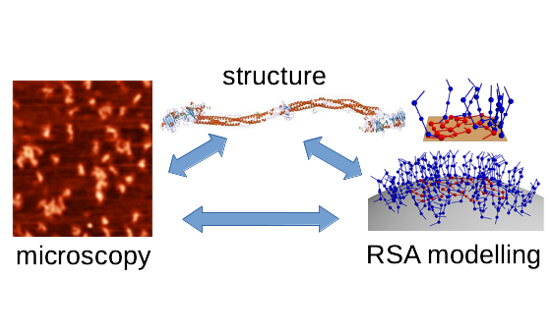
Random Sequential Adsorption (RSA) is one of the most efficient theoretical models used to investigate adsorption of macromolecules and particles, with a long-standing tradition in the field of colloid and interface science.
In the first part of this review, we demonstrate how the RSA model can be applied to interpret the experimental data and extract information about the density of the adsorption monolayer, the kinetics of its growth, and microstructural properties such as pair-correlation function and monolayer roughness. We briefly summarized the most important generalizations of the RSA model for monolayers and reviewed its extensions considering, e.g., various particle shapes, the introduction of electrostatic interaction, or adsorption on non-uniform substrates. We thoroughly scrutinized the extended RSA model developed for bilayer and multilayer formation. We collected the mean saturated packing fractions of various two- and three-dimensional objects and provided the most accurate result for two-dimensional disk packing. In the second part of this paper, we summarize various numerical algorithms and techniques that allow one to effectively implement RSA algorithms. We describe efficient methods for detecting intersections of various shapes and techniques enabling generation of strictly saturated RSA packings built of a wide range of different shapes. We hinted at how an inherently sequential RSA scheme can be parallelized. Finally, we critically discuss the limitations of the model and possible directions for future studies.
Adv. Col. Interface Sci., 306 102692 (2022)
commentary of Jakub Zakrzewski in News and Views, Nature Physics
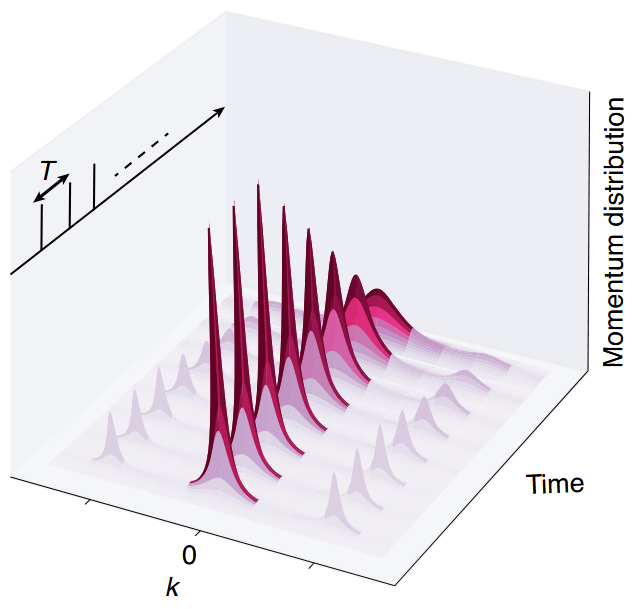
Experiment reaches the stage of testing many body localization in well controlled experiments. Two such set-ups reported their results on interacting kicked rotors in Nature Physics. Kicked rotor is a paradygmatic model for quantum chaos - will interacting rotors play a similar role in many body physics?
Picture shows delocalization in a many-body quantum kicked rotor. Evolution of the momentum (k) distribution of a gas of interacting atoms in time under a kicking with period T. The system starts from a highly localized state represented by a strongly prominent central peak. Localization persists until the effect of interactions manifests in the broadening of the peak, ultimately resulting in complete delocalization as the number of kicks increases.
Read the commentary in Nature Physics.
Romuald A. Janik, Matti Järvinen, Hesam Soltanpanahi, and Jacob Sonnenschein; publication in Physical Review Letters
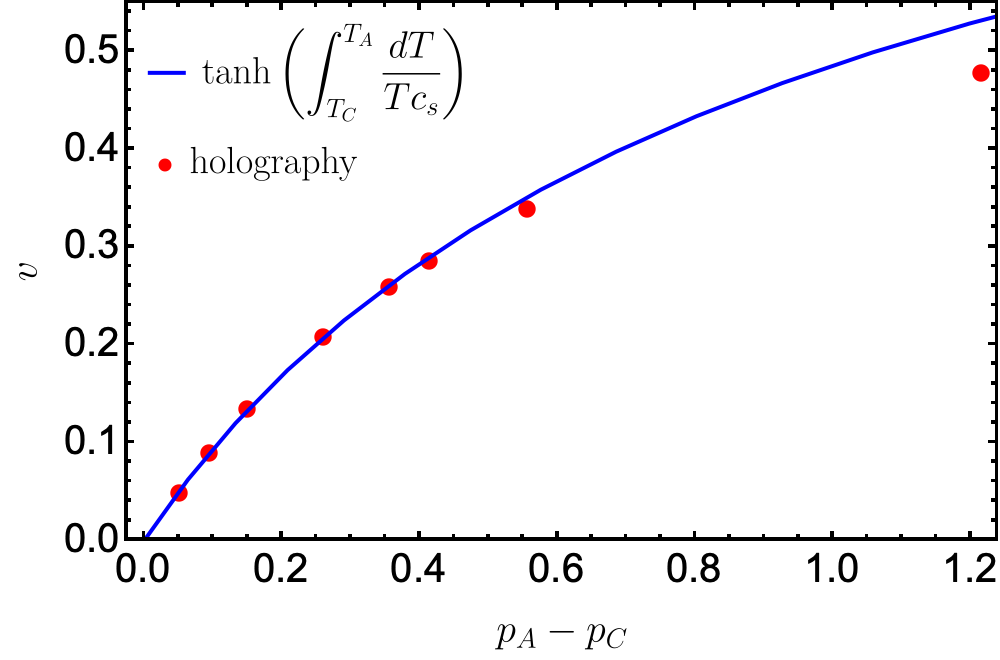
Bubble wall velocities in first order phase transitions is a topic of broad relevance, especially in view of applications to the early universe and production of gravitational waves. Conventionally, the determination of such velocities is thought to require the computation of friction, a complex non-equilibrium problem. In this article, we showed that for a range of strongly coupled theories having holographic duals, the physics is much simpler: the velocity can be expressed in terms of a perfect fluid hydrodynamic formula, and thus in terms of the equation of state in a compact form. Namely, it is given by: $v_\mathrm{domain\ wall} = \tanh \int_{p_{c}}^{p_A} \frac{dp}{(\epsilon + p)c_s} \ \equiv\ \tanh \int_{T_{c}}^{T_A} \frac{dT}{T c_s}$, where $p_C$ is the critical pressure and $p_A$ is the pressure of the high entropy phase.
Phys. Rev. Lett. 129, 081601 (2022)
Grant Maestro for Krzysztof Sacha
- The project "Czaso-tronika" by prof. Krzysztof Sacha received financial support via the grant of Maestro 13 by National Science Centre. More information under the link.
Kamil Korzekwa and Matteo Lostaglio; publications in Physical Review A and Physical Review Letters choosen as Editor's Suggestion and described in Physics Viewpoint
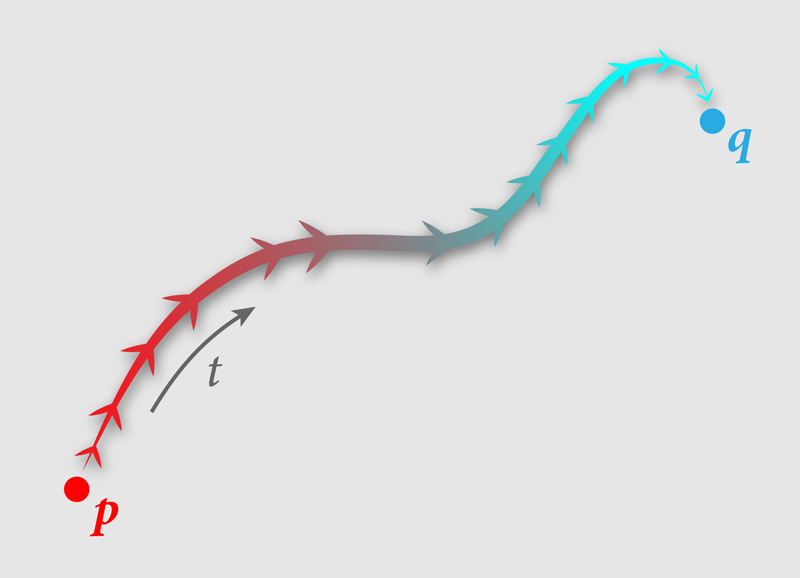
By combining continuous and discrete theoretical approaches, researchers show how to plot an optimal path from one non-equilibrium quantum state to another.
With the rapid progress in experimental control of quantum systems, we are experiencing miniaturization of heat engines, pumps and refrigerators all the way to the quantum realm, where the operation of these devices depends on a fine-tuned control of their interactions with a macroscopic thermal environment. A central problem in this setting is to find optimal interaction schedules that maximize a desired objective function, such as the efficiency of a quantum heat engine or the cooling power of a quantum refrigerator. In their works, the authors address this pressing issue by presenting a novel algorithmic approach that can solve such complex optimization problems in out-of-equilibrium setups and returns explicit elementary controls realizing optimal transformations. The framework allows one to access regimes where alternative numerical or analytical approaches are unfeasible, and it paves the way to an algorithmic approach to the development of quantum thermodynamic protocols. The usefulness of this perspective is illustrated with examples from cooling, work extraction, catalysis and the assessment of the role of memory effects in biological systems.
Phys. Rev. Lett. 129, 040602 (2022)
Phys. Rev. A 106, 012426 (2022)
Coverage in Physics Viewpoint: Physics 15, 110 (2022)
NCN grants for researchers from ITP
- dr Marcin Zagórski – Zrozumienie biofizycznych czynników ograniczających precyzję powstawania wzoru w trakcie rozwoju tkanki
- dr Mario Rainer Flory – Holograficzne powiązania między polami kwantowymi, informacją a grawitacją
- dr Chunshan Lin – Nowa fizyka w świetle pierwotnych reliktów z wczesnego Wszechświata
Titas Chanda, Maciej Lewenstein, Jakub Zakrzewski, and Luca Tagliacozzo; publication in Physical Review Letters

The Higgs mechanism is an essential ingredient of the Standard Model of particle physics that explains the ‘mass generation’ of gauge bosons. In three spatial dimensions, a spontaneous breaking of symmetry triggers the Abelian-Higgs mechanism in the system while in one spatial dimension the phase diagram onsists of a single confined phase only. Due to this boring expectation of a single phase in the continuum field theory, the Abelian-Higgs model has never been explored in 1+1 dimensional discrete lattice before. We fill this gap.
Unlike the system in continuum, two distinct regions in the lattice version are identified, namely the confined and Higgs regions. These two regions are separated by a line of first order phase transitions that ends in a second order critical point. Above this critical point these two regions are smoothly connected by a crossover. The presence of a second order critical point allows one to construct an unorthodox continuum limit of the theory that is described by a conformal field theory. (CFT).
Phys. Rev. Lett. 128, 090601 (2022)
Suhail Ahmad Rather, Adam Burchardt, Wojciech Bruzda, Grzegorz Rajchel-Mieldzioć, Arul Lakshminarayan, and Karol Życzkowski; publication in Physical Review Letters

In the paper we present analytical solution to the quantum analogue of the famous problem of 36 officers of Euler. Classically impossible puzzle turns out to be solvable in the quantum realm. The result gives a positive answer to several related questions concerning existence of a pair of quantum orthogonal Latin squares of size six, Absolutely Maximally Entangled state AME(4, 6) for four parties with six levels each, unitary matrix of size 36 with a very particular internal structure, and special classes of tensors with four indices each running from 1 to 6. Moreover, this can open new possibilities in the theory of Quantum Error Correcting Codes.
The attached picture contains four dice. If they were quantum, when rolled, the outcomes of any two would be strictly correlated with the outcomes for the other two. This roughly explains the idea behind the new AME state the existence of which has been questioned for years.
More information can be found on the JQIT website.
Phys. Rev. Lett. 128, 080507 (2022)
Michał Eckstein holds a scholarship of MEiN
Dr Michał Eckstein associated with Jagiellonian Quantum Information Team is granted a scholarship of Ministry of Education and Science for outstanding scientists.
Hossein Taheri, Andrey B. Matsko, Lute Maleki, and Krzysztof Sacha; publication Nature Communications
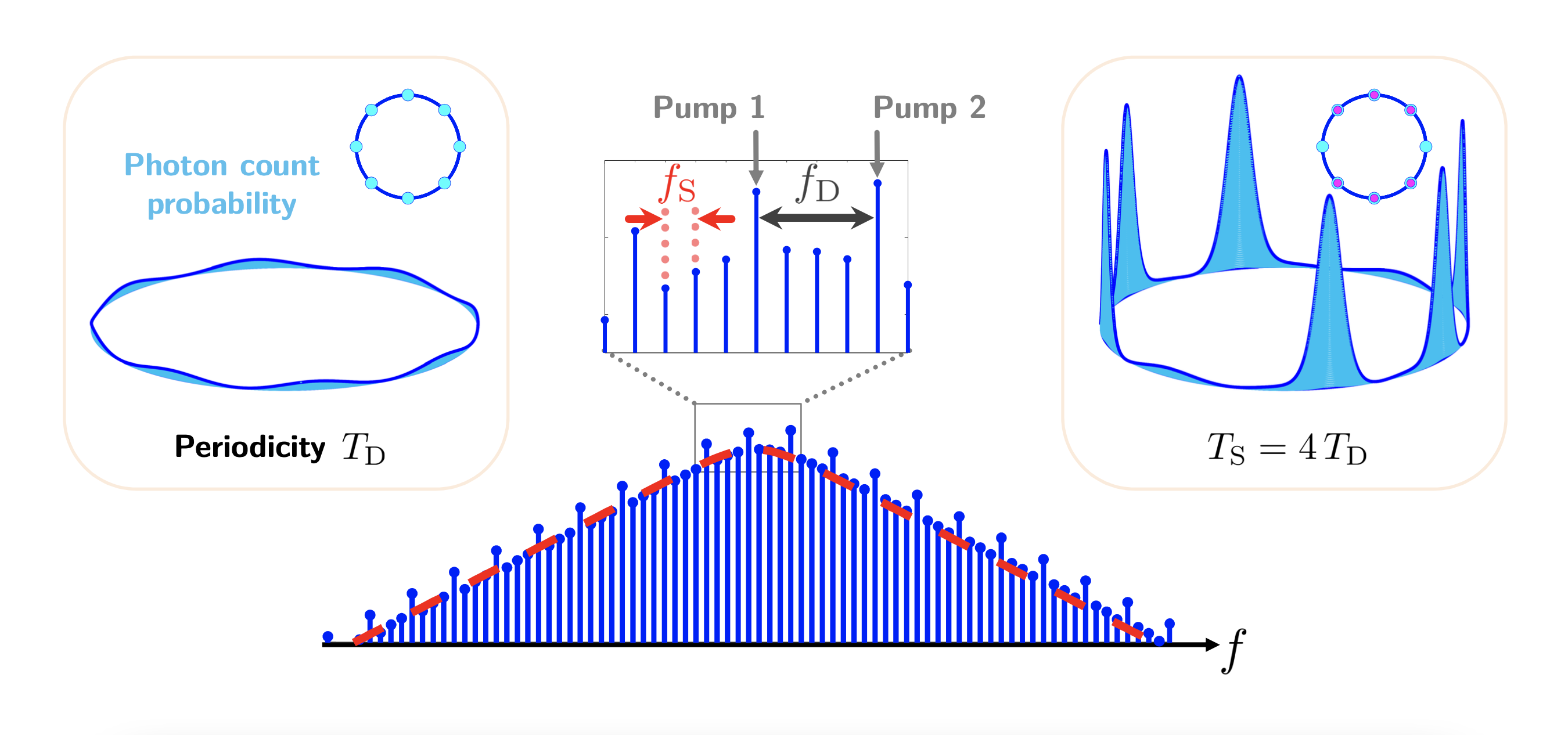
In the publication in Nature Communications, an optical platform is described in which dissipative discrete time crystalline behavior is demonstrated in the laboratory.
The experiments constitute a milestone towards chip-scale discrete time crystals, paving the way from complex labs toward real-world applications. The heart of these experiments is a tiny optical cavity (solid disc-shaped resonator of ≈1 mm diameter) pumped by two diode lasers without any need for highly complex and expensive laboratory equipment.
Discrete time crystals realized experimentally so far have been "small" crystals in the time dimension (i.e., evolving with a period twice or three times as long as the period of the external drive). In the work published in Nature Communications it is demonstrated that “big” dissipative discrete time crystals are attainable in the laboratory. Big discrete time crystals open new horizons for condensed matter research in the time domain. In the published paper, the formation of defects in discrete time crystals are described. That is, the formation of the temporal counterpart of solid-state crystals with point defects like vacancies and interstitials.
Interview in Physics World.

